This article concerns the growing of salad leave mixes in containers. In a previous post I touched upon how to grow salad leaves in containers, but now I want to go in this important topic in greater detail in what varieties can be grown, and how to make your own salad seed mixes.
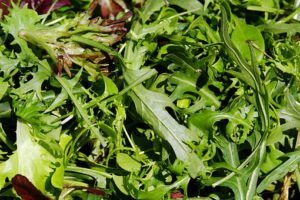
In this way, you can mix and grow your own salad leaves that you like and avoid those that you prefer not to eat. No more picking out leaves that you do not like from store bought plastic bags of young salad leaves.
I will go into the depth of what salad leaves that can be grown in containers, how to grow them, when to pick and finally how to make a mix of leaves to your own preference.
WHY YOU SHOULD GROW YOUR OWN?
When you get hungry and you have a hankering for something light, you tend to go to the supermarket and buy pre-filled plastic bags full of mixed baby leaves to make a delicious meal. This comes in a variety of forms from peppery mixes, Italian mixes, etc. This not only use single-use plastics, which is bad for the environment but often comes in a form that is not to everybody’s taste. There is a way around this for the home gardener and that is to grow your own.
For a beginner growing your own salad leaves is easy and does not require much in the way of material. It is ideal to grow in containers as you will not be constantly battling slug and snail or be worried about weeds taking over your garden.
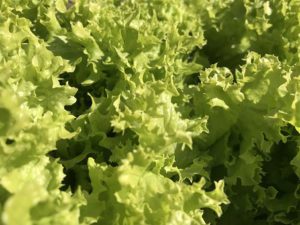
The mixes sold by seed companies are normally based on ‘Cut and come again’ leaves, which means that the first crop of leaves can be cut a few weeks after sowing. They will then grow again and can provide a second, third or fourth crop, before becoming exhausted. This multi-cropping does not occur for all varieties of salad leaves, so be warned you cannot be expected to treat them alike.
THIS COULD LEAD TO PROBLEMS
This leads to a major problem as some varieties grow more vigorously than others, whilst certain crops will not produce a viable second crop. The result would be that the mixture composition will change over time, where the leaves that remain will become unbalanced. It is best when growing mixes to find which salad leaves you like and then grow them individually in separate pots. In this way, you can mix your own salad to your own preference, without losing any additional crop.
You can mix baby leaves with traditional large chicory or iceberg lettuce leaves to make a more interesting salad. It is not expensive to do and you will be harvesting leaves in a short time.
STEP BY STEP GROWING GUIDE
All salad leaves can be grown in a similar way, as long as you follow this recommended guide.
- In container choose a waterproof receptacle that has enough drainage hole and enough volume to allow the roots to develop. Shallow troughs and window boxes are ideal, along with a large pot that has a diameter of 25cm. Fill the container with a moisture retentive multipurpose compost. Sow the seeds thinly at a distance between 1 to 3cm between each seed, and then cover with a fine sprinkling of compost.
- Use the recommended sowing time on the seed package as a guide to when to sow. As a general rule salad leaves are sown between April and August for harvest in May to October. Seeds sown in April will require frost protect, so cover with a cloche or horticultural fleece.
- With come and cut again varieties the leaves should be ready to be harvest in 3-4 weeks after sowing. The leaves should be around 10cm tall, where they can be cut to 2-3cm above the compost level by using scissors. Do not pick by hand as you can damage the plant. Always leave a few leaves intact to allow the plant to re-sprout successfully and to recut in a few weeks’ time. This is so dependent on the variety used and growing conditions if you can cut it more than one time. As said previously some can be harvested 4 times before the plant resources become depleted and the plant dies.
- Keep the compost moist at all times, as dryness will encourage them to bolt. Remove any plants that have bolted, as the leaves will be bitter and inedible.
Some plants may not re-sprout, whilst others such as Pak Choi are pulled up as small plants, which are harvested for their young succulent leaves. It is highly recommended that you should sow every few weeks to make sure that you have enough leaves to last the whole summer,
MAKE YOUR OWN SALAD MIXES
In online stores and garden centres seed packets of baby leave mixture are widely available. This is not the only viable option as you can make your own using individual seed packets.
Below are types of mixes that you can make or be commercial bought. Please note you can use all the suggested varieties or you can omit those that you do not like. Later on, the description of each variety will be discussed in greater detail.
Mesclun Mix
This is one of the most popular mixes and is often listed in seed catalogues. It often contains Endive, Mizuna, Kale, Mustard Greens, Lamb’s Lettuce, Lettuce, Chervil, Rocket, and Sorrel. It may contain all or a mixture of some of these varieties.
Misticanza Mix
This is an Italian mix which tends to be heavy in chicory, with added optional extras. It normally contains Chicory, Radicchio, Endive, Rocket, and Watercress.
Spicy Mix
If you like your salad leaves to be spicy and have a kick to them, then the following mix is for you. It normally contains Cress, Rocket, Mustard, and Mizuna.
Herby Mix
If you like your salads to have a more herby taste, then this mix is for you. You can use any of the following Mustard, Wild Rocket, Lettuce, Coriander, Mizuna, Baby Swiss Chard, Chervil and Parsley.
Oriental Mix
If you like a more exotic mix of salad leaves that you can go no wrong if you use the following; Pak Choi, Mizuna, Choy sum, mustard, perilla or tatsoi.
French Mix
If your preference is for salad leaves that come from influences across the pond, then you can use the following salad leaves: Lettuce Lollo Rosso, Lamb’s Lettuce, Sorrel, Chervil, and Dandelion.
You can also make your own depending on your taste and preference, so if you like it French and spicy there is nothing stopping you from doing this. There are no rules to what you can mix, so go crazy if you want.
The following leaves can be used to make your favourite salad mixes.
AMARANTH

This plant has a long history as a grain crop, but only recently established as a source of baby leaves for the home gardener. If you have a choice go for the red leave variety, as they are more vigorous than green varieties.
They will also be very colourful in any mixed leaf salad. The flavour of the leaves is impossible to describe but to experts they describe it tasting like Orange. It is not fully hardy and so the seeds must be sown in mid-May after the last frosts.
BULL’S BLOOD BEETROOT

Bull blood beetroot is a beetroot that is not grown from the roots but the green red-veined leaves that it produces. It starts off this colour but as they age they turn a deeper red colour. You can really sow thickly as you are harvesting the young leaves and not the roots.
CHICORY
There are two types of chicory that will add colour and crispness to any autumn and winter salad. You will find them refreshing and tangy, or you will find them to be bitter.
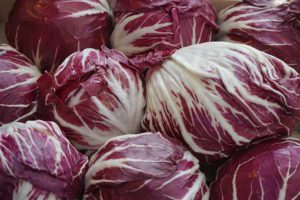
The first type is the forcing chicory that produces ‘Chicons’, which are the plump, leafy heads that are produced from roots kept in the dark during the winter months. This is not applicable to summer container garden growing.
The second type is not forced and are not blanched and are left to grow naturally. Radicchio is the usual red variety that is popular one to grow and use in salads.
Radicchio heads are lettuce like, where the red colour deepens as the weather gets colder and the days get shorter. Cropping starts in autumn, where chicory can be used to extend the growing season.
CHERVIL
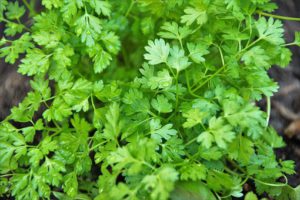
Chervil grows quickly, where the first leaves can be picked about 8 weeks after sowing. Sow where it is to grow and then thin to about 15cm apart. Do not allow the compost to dry and so water regularly. Pick outer leaves for use in salads first whilst removing the unwanted flowers at the same time and dispose of. The aniseed flavour is short-lived and so add it to your salads at the last moment.
CHOY SUM

This is a relative of Pak Choi and is very popular in Chinese cooking. You will need to search for a seed supplier in the UK. The fleshy stalks are the reason why the plant is grown, which are cut when the flowering buds start to appear.
Sow the seeds between May-September for a July-November crop. It is not an easy plant to grow so you will need to persevere to get a decent crop. You will need to successional sow to produce a crop throughout the growing season, as it can be only harvested once.
CRESS

Salad leaf cress is more broadly leaved than those grow indoors and harvested young. These varieties are cut at a much taller stage, where their parsley-like leaves give a peppery kick to any salad.
CORIANDER
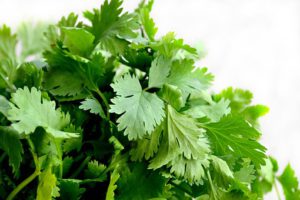
The aromatic leaves will give a spicy kick to salads, where a citrus-like flavour is introduced. You need to pick a sunny spot, where the seeds are sow in spring. Thin the seedlings to 10cm apart to allow the plant to flourish. Grow the variety ‘Leisure’ if you want a leave producing coriander instead of one that is harvested for its seeds.
DANDELION
I know most of you will be shocking in thinking a weed can be harvested as a food for any salad. You will be surprised that dandelion leaves have been eaten since medieval times. The leaves need to be blanched, and this is accomplished by excluding light from hitting the plant. The leaves turn paler and sweeter and then can be cut and used in salads.
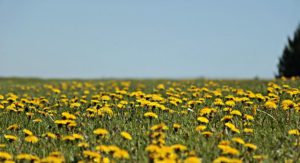
You cannot use the common garden dandelion as the leaves are not big enough, so you need to find and buy a variety that has been bred to produce larger broad leaves.
Sow them in April in containers full of multipurpose compost. In the following spring (not this year) cover each plant with a dark pot (as long as it excludes light, it does not matter what you use. This will allow the blanching process to start, and after ten days the leaves will be white and can be harvested for salads.
ENDIVE
Endives are the basic feature of salads on the continent, but not much so in Britain. This is despite endives have more flavour than lettuce. By sowing at monthly intervals in spring and summer, you can have heads of endives for six months or more.
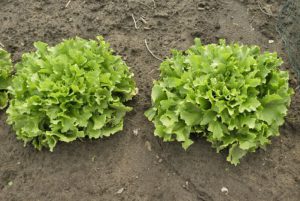
Endives come into two types, a curly-leaved one and a broad-leaved one, which has more lettuce-like leaves. Both can be used in salad, although the latter is often cooked and used in making soups and other vegetable dishes.
‘Frisee’ is the normal variety to grow in containers as a mixed baby leaves salad.
KALE
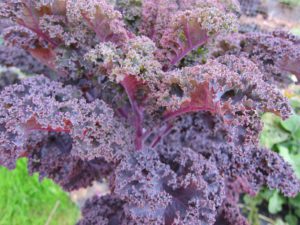
Kale is normally eaten as a cooked vegetable but it may seem surprising that there are several varieties that can be eaten raw and can be used as a salad ingredient. ‘Fizz’ has been specially bred for its leaves that can be used in salads, whilst red-stemmed kale is often found as part of a salad mix in shop bought bags.
LAMB’S LETTUCE

The main advantage of lamb’s lettuce (or Corn Salad as it is alternatively known) has over lettuce is that its small leaves can be harvested between November to January, where fresh salad leaves are rare. Sow in August to September, thinning the plant to 15cm as the plant matures. The thinnings can be used in salad, so nothing goes to waste.
During winter a few leaves from each plant can be harvested, and used in salads. Do not over pick as this will deplete and kill the plant. To some people, it is too bitter to eat, and so can be blanched in the same way as recommended for dandelions.
LAND CRESS/AMERICAN CRESS

This is often used as a substitute for watercress. It needs to be successional sow from early spring to autumn, where you can pick the peppery leaves from April to November. Easy to grow, all you need is a moist compost and spot in the shade.
LEEF BEET/SWISS CHARD
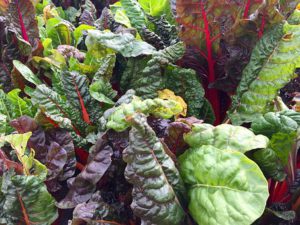
The name Leaf beet and Swiss chard can be used interchangeably as they are the same thing. It is often cooked and used as a spinach substitute. Young leaves, on the other hand, can be used raw in salads. The colourful stalks and veins of the leaves provide interest and texture to salads. There are many popular varieties that can be grown, these include ‘Rhubarb Chard’, ‘Oriental Intense’ and ‘Canary Yellow’.
LETTUCE
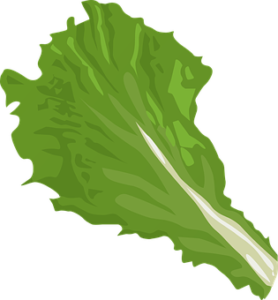
This is a mainstay of any salad, where lettuce such as iceberg is often used. There are alternatives which could be used as part of salad leave mixes. Green varieties are used such as ‘Green Oakleaf’, but more often red edge frilly types are used, such as ‘Lollo Rosso’ and ‘Red Oakleaf’. Several cuts can be taken from each plant.
MIZUNA

This is a popular ingredient in salad leaves mixes. The seed can be successionally sown in spring and summer to give harvest from late spring to early winter. The green leaves provide a peppery taste to any salads. It prefers to be grown in a light shady area.
MUSTARD
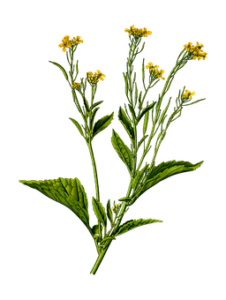
This is an excellent choice for salad leaves, where you will need to sow seeds every few weeks to have a continuous supply throughout the growing season of April to November. The leaves come in a variety of shapes from oval to feathery.
The colours are also interesting as you can have white-veined green to all over red leaves. They have a range of taste from mustard to peppery, with the strength increasing with leaves age. There are so many popular varieties that are available, so choose your own.
NAMENIA

A salad leaf vegetable that has a crunchy texture and tangy taste. It may be hard to find, but it is worth the hunt for, as it can crop in two weeks. That’s right it only takes two weeks from sowing to harvest, so many successional sowing will be required.
PAK CHOI

The oriental vegetable is often found in the supermarket, where it is immediately recognized. It has a slightly spicy flavour and can be harvested when the plant reaches 10cm tall, where it can be cut and used as salad leaves. The time between sowing and harvesting the leaves for salad is one month. You can leave the stumps to re-sprout and provide a supply of new leaves for several months. There are many varieties that can be used for this purpose
PARSLEY
See growing herbs in containers in how to grow this herb.
PEA SHOOTS
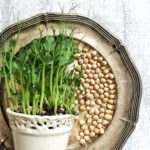
Pea shoots are an ideal salad ingredient, which imparts a crisp texture and a pea-like flavour. All varieties are suitable but ‘Twinkle’ is the noted one. Pick the shoot tips after a few weeks after sowing you can then continue to pick small shoots throughout the life of the plant.
PERILLA

If you want a usual salad leave then this is a plant for you. It is one of the rarer salad leaves to find, as you will need to search high and low to find a supplier. It is mainly used as a garnish and to add interest to salads in China and Japan. The flavour is unique, and the leaves come in green or red colouration.
PURSLANE

Winter purslane or miner’s lettuce is used as a cut and come again salad leaves, where it will crop all winter. The leaves are best whilst young. ‘Golden Purslane’ has yellowish green leaves and red stems that look great in salads.
ROCKET
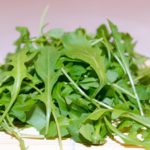
Rocket is found in all garden centres and catalogues. Sow it in containers between March and August. The leaves can be cut 3-4 weeks after sowing, and is a cut and come again vegetable. This cannot be trusted, so to have a continuous supply it is better to sow seeds every 2-3 weeks.
The leaves are peppery but this varies depending on the variety sown and its growing conditions. Wild rocket has the strongest flavour, whilst ‘Voyager’ has the most vigour. ‘Sky Rocket’ combines the two traits, whilst ‘Buzz’ grows all year round.
SORREL
This perennial is often grown in France but rarely sown or seen by the British. It is a perennial and can be propagated by planting seeds or by plant division. Sow seeds in April, thinning the young plants to one per container. Little attention is needed, but watering is required in dry weather.
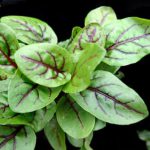
Pick a few leaves at a time from each plant as soon as they are big enough to be used. Small leaves are less bitter than large ones, once the plants are established you will be harvesting leaves at regular intervals from March until November.
‘Red Veined’ has been specially bred as a cut and come again salad leaves, where it has a citrus-like flavour and attractive red leaves.
SPINACH
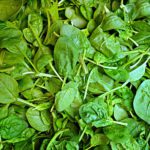
This is not added to salads to impart flavour but added to give colour. The flavour is best described as bland but the shape of the leaves introduces more interest than the normal round lettuce found on sale. Salad varieties include ‘Lazio’, ‘Reddy’ and ‘Red Cardinal’. You need to successional sow to have a continuous supply throughout the growing season.
TATSOI/ROSETTE PAK CHOI

The dark green leaves form a decorative rosette, where each spoon-shaped leaves are carried on a pale green stem. The leaves can be harvested at any stage from baby to full maturity, where it can be used in salads and other oriental recipes. It is more slow growing than Pak Choi but has a better flavour. It is a very useful ingredient in winter mixes as it will tolerate cold weather.
WATERCRESS
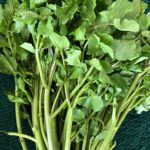
There is only one variety that can be grown that does not require running water, and that is ‘Aqua’. This variety will quite happily grow in a container full of multipurpose compost provided it is moist at all times. Best to cut the leaves whilst young, where they will provide a crunchy and peppery flavour to any salads.
CONCLUSIONS
In this article, growing your own salad leave mixes in containers have been discussed. Instead of buying prepared salad leaves, you can make your own to the way that you like it. In this article, many suggestions have been made, and this will enable you to be confident in making the right selection for you and how to grow them.
The choice is large and everybody’s taste are different, so using the information provided in this article you can make your own.
Tell me what is your favourite salad leaves mix is in the comment box below, or if you have a burning question, do so in the usual place.
Happy salad eating.

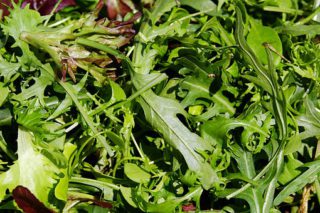
Hi Antonio
I came across this site while I was looking for some new ideas for easy foods to grow at home, specifically salad because I am so fed up of throwing away half-eaten bags of pre-prepared salad. I watched a programme on TV lately where they demonstrated the dangers of food poisoning from bagged salads, particularly if they start to go a bit wet and it has put me off completely. Also I am so fed up of plastic bags! So I was delighted to find your brilliant site today and I wanted you to know I have book-marked this page because it is the most comprehensive list of salad leaves available including some of the oriental ones that I had not heard of and it never crossed my mind that you could even grow things like Pak Choi here in the UK. That stuff is really expensive in the supermarket but you have filled me with confidence to give it a go.
From my experience of growing salad leaves in the past though I have found that although they were fairly easy to grow, they seemed to attract aphids, green and even black ones, in abundance. It was because of this that I stopped growing salad leaves outdoors. I hate aphids, greenfly and that sort of thing, honestly, I am not a natural gardener and those little bugs just make me shudder and put me off eating the leaves (yes, of course I wash them but the thought of those flies is in my mind!).
In the past I sprayed the plants with watered-down washing up liquid but I wondered what tips you have for fighting off the aphids naturally? Are there any plants I can plant alongside my salads to prevent aphids or attract more ladybirds or whatever? Please help, I really need your advice. Thank you
Hi Ally
Ladybirds will be attracted by the aphids, so would be attracted by mass in infestations. Believe it or not wasps can be used to control aphids as they will feed their young on these pests. I am writing an article on insect friendly garden which will be published in the near future. The old trick is to pinch out badly infested shoots, and with cut and come again you should get unaffected leaves.
Hope that helps
Antonio
Hi Antonio
I have enjoyed your post and found it very informative for me who is just starting my garden. I only have 3 plants of aloe vera and I want to add salad to my garden. But I was really scared that it will be to much containers for my tiny oudoor space. But the idea of mixing different salads in one container just made it easy for me to decide.
So, I have bookmarked your post to guide through the process.
Thanks for sharing
Hi Adyns
I am glad you enjoyed the post very much and that you are planning you own mixed salad leaves container garden which is ideal for small places.
Thanks
Antonio
We have grown our own lettuce for years but were not aware of such variety. However, we have only grown lettuce, sorrell, swiss chard, and kale. We never looked into the proper mix for certain types of salads. Your article was in-depth about that topic and has given us a new varieties to start looking for. I was particularly interested in Lamb’s Lettuce for small harvesting in winter months but we live in the Pacific Northwest and not sure if it will be successful due to the lack of sun and moist conditions. Any thoughts or other suggestions?
Hi Mike
Thank you for those kind words. During the cold winter months your choice is very limited and Lamb’s lettuce is the only really crop that you can use. Sorry about that but think about all the salads that you can eat during the spring and summer months.
Thanks
Antonio
I’m glad that you are also promoting a plastic free environment aside from growing your own vegetable. It’s awesome that you have a wide variety of option when it comes to vegetable mixes. Watercress is so easy to grow in our backyard. It keeps on sprouting everywhere especially during rainy season. We have so much to give to our neighbors.
Can oriental mix grow with french mix? As we’re.located in Southeast Asia, oriental mix would be easy to grow but I also want to try the french mix. I am not sure though if it can grow in a tropical country, considering the weather here is hot. I’m also thinking if it can grow in our type of soil.
Thank you once again for your article. It was worth reading. It’s not just about gardening but sustainability and environmental concern as well. Keep posting!
Hi MissusB
Thank you for those kind words. The beauty of this article is to show that you can mix any seeds you want, so you can have a French mix and Oriental mix, as you can tailor to your own tastes and preference. As long as you van find the seeds you can do anything you like.
Thanks
Antonio
We have grown our own salad for about as long as i can remember and we have experimented with lots of different mixes, i am not sure if there is one mix that I favour over the other as growing a variety of mixes through staggered planting provides plenty of variety throughout the summer months.
one tip that i would press home though is never to sow out of date seeds, as i have this year, it is almost certain to result in crop failure.
Hi Adrian
I am sorry that you have had trouble with your seeds this year. You can try pre-sprouting old seeds in a damp kitchen towel in a closed box to see if the seeds are viable or not. If after 3 days nothing happens then it is a bad batch of seeds and you need to buy new seeds.
Thanks
Antonio
Well I’ve successfully grown water cress before in the past, but unfortunately I’ve failed with other leaf versions I’ve attempted (I live in Wales so I’m putting this down to the general weather!).
If you live in a country that doesn’t necessarily have a decent summer – where would you suggest attempting to grow leaves in containers? Could you get away with window sill growing?
Hi Chris
I would not recommend growing in windowsills as you need a decent size to get a decent crop. I think most people fail as they are trying to cram too much in such a small space without watering or feeding, the result would be that the salad bolts. Try to plant thinly and see how you go.
Thanks
Antonio
Good afternoon Antonio,
Now, this is a post after my heart. I love nature and also love to grow my own food. In 2016 I “Imported” Michael from the U.S. and now he is the manager of the vegetable garden. He is getting better every year. This year there are monster Zucchini which could feed a regiment.
Not everybody is blessed with having a garden so your step by step guide how to grow the different lettuce types in containers is extremely helpful. It is true that growing in containers also helps to avoid snails and slugs. As I live on an organic farm in the south of Spain no killing allowed with dangerous chemicals. I must confess that my happy chickens do get a treat now and then.
That is a great list you present and for sure some types of vegetables are unknown to me. There really is something for all tastes. When I had beetroot growing I would take some leaves from the outer side for my own salad mixes. Thank you for all this helpful information.
Regards, Taetske
Hi Taetske
Greetings to sunny Spain. The beauty of growing your own is that you can avoid the use of fungicides and pesticides and live a healthier live. I have chosen a variety as I wanted to spice up people eating habits.
Thanks
Antonio
hello there!
Nice topic you have choosen for the article. This is interesting. Gardening is not only a fun but also good for health. Moreover having own garden specially of crops, vegetables is so good both for mental satisfaction and financial support. You have described nicely about a different thing that is the salad mix. I liked the spicy salad mixes most.
Thanks for a different idea.
Hi Zihad
Salad growing has become more interesting and as we become more health consciousness then we need to grow our own. This article does this.
Thanks
Antonio
I just love salad. I have a small container garden of salad leaves. In my garden I used containers as you said in your amazing post. In my garden I grow Spinach, Rocket, Pea shoots, Lettuce and Pak choi. I wanted to grow Perilla in my container garden. But really it is rare. I am very glad to see your salad recipes. I love Mesclun mix salad very much. But I did not know how to make it. From your article I recognize about it. I really like your helpful post and I will share it to others. Though Perilla is very rare to get, could you inform me how can I get it easily?
Thanks a lot dude 😉
Hi Snigdha
Thank you very much for those kind words as they where very much appreciated. Perilla should be available if you order online via a specialised seed supplier. I hope this helps
Antonio